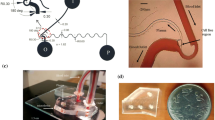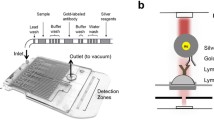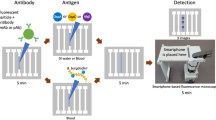Abstract
Serological surveys are vital to determining the prevalence of a disease and/or the immunity status against it in any population. However, the relatively large sample volume requirement (1–10 mL) in traditional serum-based assays demands that blood draw camps be set up by medical professionals to obtain samples for these studies which significantly increases the time and cost associated with them. Here we address these drawbacks of a serosurvey by reducing the whole blood requirement in its diagnostic procedures down to 10 μL using the microfluidic platform. Such a miniaturization approach was demonstrated in our current work by developing a microchip based serological device for determining the serum levels of West Nile (WN) viral antibodies (IgG and IgM) to assess the immunity status against WN virus in Fremont County, Wyoming. Enzyme-linked immunosorbent assays (ELISA) were developed for these target analytes in glass microchannels to accomplish this task using antibodies/assay reagents purchased from commercial sources. The reported assays were directly quantitated using a fluorescence microplate reader which to our knowledge is the first account of signal measurement in a microchip based ELISA procedure using this standard instrument. To enable this quantitation method, the assay channels on our device were spaced identically as the wells on a commercial microplate, and a holder having the dimensions of this plate was used to accommodate the microchips. Our microfluidic assays showed an excellent correlation with the results from the microwell plate based experiments for significantly lower incubation periods and using only 3 μL of the ELISA reagents.




Similar content being viewed by others
References
F.M. Cowan, A.M. Johnson, R. Ashley, L. Corey, A. Mindel, BMJ 309, 1325 (1994)
E.B. Hayes, N. Komar, R.S. Nasci, S.P. Montgomery, D.R. O’Leary, G.L. Campbell, Emerg. Infect. Dis. 11, 1167 (2005)
D. Huber, J. Rudolf, P. Ansari, B. Galler, M. Fuhrer, C. Hasenhindl, S. Baumgartner, Anal. Bioanal. Chem. 394, 539 (2009)
Z.C. Karakoc, B.M. Tuzuner, O. Ergonul, A. Pierro, E. Di Fonzo, I. Koruk, V. Sambri, Vector Borne Zoonotic Dis. 13, 739 (2013)
D.M. Kemeny, S.J. Challacombe, ELISA and other solid phase immunoassays: theoretical and practical aspects (Wiley, New York, 1998)
E. Miller, K. Hoschler, P. Hardelid, E. Stanford, N. Andrews, M. Zambon, Lancet 375, 1100 (2010)
P.M. Munoz, C.M. Marin, D. Monreal, D. Gonzalez, B. Garin-Bastuji, R. Diaz, R.C. Mainar-Jaime, I. Moriyon, J.M. Blasco, Clin. Diagn. Lab. Immunol. 12, 141 (2005)
Z. Peterfi, B. Kocsis, J. Immunoass 21, 341 (2000)
X. Pourrut, D. Nkoghe, J. Paweska, E. Leroy, Virol. J. (2010). doi:10.1186/1743-422X-7-132
H.E. Prince, L.H. Tobler, M. Lape-Nixon, G.A. Foster, S.L. Stramer, M.P. Busch, J. Clin. Microbiol. 43, 4316 (2005)
D.R. Reyes, D. Iossifidis, P.A. Auroux, A. Manz, Anal. Chem. 74, 2623 (2002)
S. Sentsui, T. Nishimori, I. Nagai, N. Nishioka, J. Vet. Med. Sci. 58, 1 (1996)
L. Szekel, A. Guttman, Electrophoresis 26, 4590 (2005)
G. Tardei, S. Ruta, V. Chitu, C. Rossi, T.F. Tsai, C. Cernescu, J. Clin. Microbiol. 38, 2232 (2000)
G.M. Toh, N. Yanagisawa, R.C. Corcoran, D. Dutta, Microfluid. Nanofluid. 9, 1135 (2010)
V.C.W. Tsang, B.C. Wilson, S.E. Maddison, Clin. Chem. 26, 1255 (1980)
Wyoming Department of Health, http://wdh.state.wy.us/phsd/skeeter/index.html Accessed 14 March 2011
N. Yanagisawa, D. Dutta, Biosensors 1, 58 (2011)
N. Yanagisawa, D. Dutta, Anal. Chem. 84, 7029 (2012)
N. Yanagisawa, J.O. Mecham, R.C. Corcoran, D. Dutta, Anal. Bioanal. Chem. 401, 1173 (2011)
E.J. Young, Rev. Infect. Dis. 13, 359 (1991)
Acknowledgments
This research work was supported by grants from the National Science Foundation (DBI 0964211) and the Wyoming INBRE program (grant # P20RR016474 and P20GM103432).
Author information
Authors and Affiliations
Corresponding author
Rights and permissions
About this article
Cite this article
Pena, J., McAllister, S.J. & Dutta, D. A glass microchip device for conducting serological survey of West Nile viral antibodies. Biomed Microdevices 16, 737–743 (2014). https://doi.org/10.1007/s10544-014-9878-9
Published:
Issue Date:
DOI: https://doi.org/10.1007/s10544-014-9878-9




